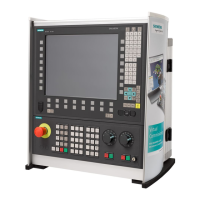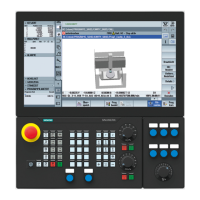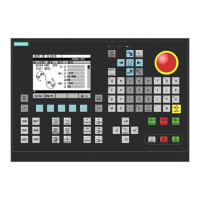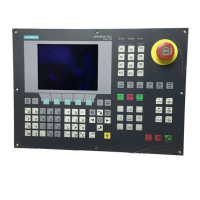Detailed Description
2.7 Program operation mode
Mode Group, Channel, Program Operation, Reset Response (K1)
2-104 Function Manual, 08/2005 Edition, 6FC5397-0BP10-0BA0
%100
N120 M30
M17
N20 X ...Y ...
N10 R1=34 ...
ABHEB_Z
N80 ...
N30 ...
Main program/subroutine Interrupt routine
N10 SETINT ...
N20 ...
N40 ...
N50 ...
N60 ...
N70 ...
N90 ...
N100 ...
N110 ...
Assign one routine to one event
and switch to "ready"
Event
(input switched)
Block being
processed
Return possible
Fig. 2-11 Working with interrupt routines
Parameterization by SETINT
An interrupt signal must be assigned to the part programs via NC instruction SETINT. This
turns the part program into an interrupt routine.
The following parameters can be used in the SETINT instruction:
• LIFTFAST: When the interrupt signal arrives, a "Fast retraction of the tool from the
contour" is executed before the interrupt routine starts. The motion direction for the fast
retraction is specified by NC address ALF.
If mirroring is active for execution via frames, machine data
MD21202 $MC_LIFTFAST_WITH_MIRROR can be used to control whether the direction
of retraction is to be mirrored as well during fast retraction.
The displacement for the fast retraction is stored for the 3 geometry axes in
MD21200 $MC_LIFTFAST_DIST (displacement during fast retraction from contour).
If LIFTFAST (fast retraction) is assigned, the maximum axis acceleration for positioning
operations (MD 32300: MAX_AX_ACCEL) is reduced by the factor entered in
MD20610 $MC_ADD_MOVE_ACCEL_RESERVE (acceleration reserve for overlaid
motions).
• BLSYNC: If this parameter is set, the current program block is processed and only then is
the interrupt routine started.
References: /PG/, "Programming Guide: Fundamentals"
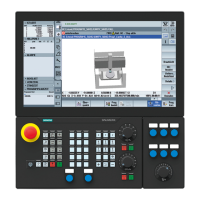
